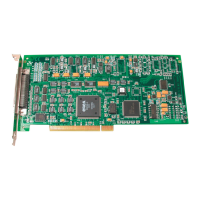Appendix A
80
Pseudo-Differential Inputs
Pseudo-differential inputs allow one common-mode voltage for all
single-ended inputs. With this type of connection, the low side of the
instrumentation amplifier is used to sense an external common-mode
voltage. For example, if you have a signal-conditioning rack, the
AMP LOW signal connects to the analog common of the external
rack.
The pseudo-differential configuration allows you to use the
maximum number of input channels, while placing an impedance
between the external ground and the data acquisition ground or
analog common. Even if it is 100 Ω, this impedance provides the bias
return currents for the inputs and causes only 10 mA of current to
flow with a ground potential difference of 1 V. (The input bias current
is typically in milliamperes.) This is usually manageable by the
common-mode range of the instrumentation amplifier and analog
ground system. Consider the problems with 1 Ω of impedance
between 1 V of potential difference. The resulting 1 A of current
causes many problems in the analog signal integrity.
If it is provided and not used, ensure that you connect AMP LOW to
the analog common of the data acquisition board or to ground when
running in single-ended mode.
Differential Inputs
Differential inputs offer the maximum noise rejection at the expense
of half your total channel count. For the best results, shielded twisted
pairs are a must. The shield must connect at one end so that ground
currents do not travel over the shield. In low-level voltage
applications, differential inputs reduce problems not only due to
electrostatic and magnetic noise, but due to cross-talk and thermal
errors.
One problem to consider with differential inputs is the bias current
error. The differential impedance is usually hundreds of megaohms.

